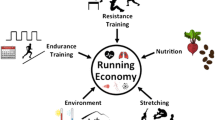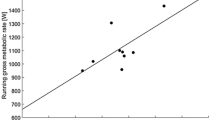Abstract
The cross-training (XT) hypothesis suggests that despite the principle of specificity of training, athletes may improve performance in one mode of exercise by training using another mode. To test this hypothesis we studied 30 well-trained individuals (10 men, 20 women) in a randomized longitudinal trail. Subjects were evaluated before and after 8 weeks of enhanced training (+10%/week), accomplished by adding either running (R) or swimming (XT) to baseline running, versus continued baseline running (C). Both R ( − 26.4s) and XT (− 13.2s) improved time trial (3.2 km) performance, whereas C did not (− 5.4s). There were no significant changes during treadmill running in maximum oxygen uptake (O2peak; − 0.2, − 6.0, and + 2.7%), steady state submaximal O2 at 2.68 m · s−1 ( − 1.2, − 3.3 and + 0.2 ml · kg−1 · min−1), velocity at O2peak (+0.05, +0.25 and +0.09 m · s−1) or accumulated O2 deficit (+ 11.2, − 6.1 and + 9.4%) in the R, XT or C groups, respectively. There was a significant increase in velocity associated with a blood lactate concentration of 4 mmol · l−1 in R but not in XT or C ( + 0.32, + 0.07 and + 0.08 m · s−1). There were significant changes in arm crank O2peak ( + 5%) and arm crank O2 at 4 mmol · l−1 ( + 6.4%) in XT. There was no significant changes in arm crank O2peak ( + 1.3 and − 7.7%) or arm crank O2 at 4 mmol · l−1 ( + 0.8 and + 0.4%) in R or C, respectively. The data suggest that muscularly non-similar XT may contribute to improved running performance but not to the same degree as increased specific tranining.
Similar content being viewed by others
References
Banister EW, Good P, Holman G, Hamilton CL (1986) Modeling the training response in athletes. In: Landers DM (ed), Sport and elite performers. Human Kinetics Champaign, pp 7–23
Borg G, Hassmen P, Lagerstrom M (1987) Perceived exertion related to heart rate and blood lactate during arm and leg exercise. Eur J Appl Physiol 65: 679–685
Coen B, Schwarz L, Urhausen A, Kinderman W (1991) Control of training in middle and long distance running by means of the individual anaerobic threshold. Int J Sports Med 12: 519–524
Daniels JT, Yarbrough RA, Foster C (1978) Changes in O2peak and running performance with training. Eur J Appl Physiol 39: 249–254
Foley MJ, McDonald KS, Green MA, Schrager M, Snyder AC, Foster C (1991) Comparison of methods for estimation of anaerobic capacity (abstract) Med Sci. Sports Exerc 23: S34
Foster C (1983) O2 and training indices as determinants of competitive running performance. J. Sports Sci 1: 13–22
Foster C (1988) Translation of exercise test response to exercise prescription. In: Oldridge NB, Foster C, Schmidt DH (ed) Clinical exercise programs Mouvement Publications, Ithaca, N.Y., pp 169–178
Foster C, Green MA, Snyder AC, Thompson NN (1993) Physiological responses during simulated competition. Med Sci Sports Exerc 25: 877–882
Gilman MB, Wells CL (1993) The use of heart rates to monitor exercise intensity in relation to metabolic variables. Int J Sports Med 14: 339–344
Hickson RC, Foster C, Pollock ML, Galassi TM, Rich S (1985) Reduced training intensityies and loss of aerobic power, endurance and cardiac growth. J. Appl Physiol 58: 492–499
Hoffmann JJ, Loy SF, Shapiro BL, Holland GJ, Vincent WJ, Shaw S, Thompson DL (1993) Specificity effects of run versus cycle training on ventilatory threshold. Eur J Appl Physiol 67: 43–47
Lehmann M, Baumgartl P, Wiesneck C (1992) Training-overtraining: Influence of a defined increase in training volume vs training intensity on performance, catecholamines and some metabolic parameters in experienced middle and long distance runners. Eur. J Appl Physiol 64: 169–177
Lewis S, Thompson P, Areskog N-H, Vodak P, Marconyak M, DeBusk R, Mellen S, Haskell W (1980) Transfer effects of endurance training to exercise with untrained limbs. Eur. J Appl Physiol 44: 25–34
Loy SF, Holland GJ, Mutton DL, Snow J, Vincent WJ, Hoffmann JJ, Shaw S (1993) Effects of stairclimbing vs run training on treadmill and track running performance. Med Sci Sports Exerc 25:1275–1278
MacRae HSH, Dennis SC, Bosch AN, Noakes TD (1992) Effects of training on lactate production and removal during progressive exercise in humans. J Appl Physiol 72: 1649–1656
Mazzeo RS, Brooks GA, Schoeller DA, Budinger TF (1986) Disposal of blood lactate in humans during rest and exercise. J. Appl Physiol 60: 232–241
McArdle WD, Magel JR, Delio DJ, Tonier M, Chase JM (1978) Specificity of run training on O2max and heart rate changes during running and swimming. Med Sci Sports Exerc 10: 16–19
McLellan TM, Skinner JS (1981) The use of the aerobic threshold as a basis for training. Can J Appl Sport Sci 6: 197–201
Medbø JI, Burgers S (1990) Effect of training on the anaerobic capacity. Med Sci Sports Exerc 22: 501–507
Medbø JI, Mohn A-C, Tabata I, Bahr R, Vaage O, Sejersted OM (1988) Anaerobic capacity determined by maximal accumulated O2 deficit. J. Appl Physiol 64: 50–60
Mutton DL, Loy SF, Perry DM, Holland GJ, Vincent WJ, Heng M (1993) Effect of run vs combined cycle/run training on aerobic capacity and running performance. Med Sci Sports Exerc 25: 1393–1397
Olesen HL (1989) Anaerobic capacity; uphill running-a clue to its accurate determination (abstract) Acta Physiol Scand 140: 33
Olesen HL (1992) Accumulated oxygen deficit increases with inclination of uphill running. J Appl Physiol 73: 1130–1134
Pollock ML, Dimmick J, Miller HS, Kendrick Z, Linnerud AC (1975) Effects of mode of training on cardiovascular function and body composition of middle aged men. Med Sci Sports 7: 139–145
Sjodin B, Jacobs I, Svedenhag J (1982) Changes in onset of blood lactate accumulation (OBLA) and muscle enzymes after training at OBLA. Eur J Appl Physiol 49: 45–57
Stainby WN, Brooks GA (1990) Control of lactic acid metabolism in contracting muscles and during exercise. In: Pandolf KB, Holloszy JO (eds) Exercise and sports sciences reviews, vol 18. Wiliams and Wilkins, Baltimore, pp 29–64
Author information
Authors and Affiliations
Rights and permissions
About this article
Cite this article
Foster, C., Hector, L.L., Welsh, R. et al. Effects of specific versus cross-training on running performance. Europ. J. Appl. Physiol. 70, 367–372 (1995). https://doi.org/10.1007/BF00865035
Accepted:
Issue Date:
DOI: https://doi.org/10.1007/BF00865035




